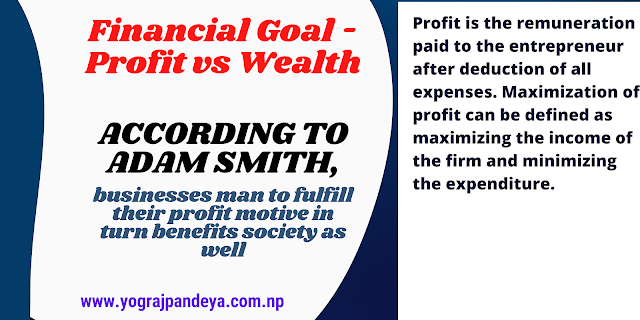Financial Goal - Profit vs Wealth
Every business has a specific purpose or objective in mind. As a result, the most important purpose of a financial manager is to improve the financial well-being of the owner. In this context, economic welfare could refer to profit maximization or shareholder wealth maximization. As a result, when it comes to a company's financial goals, shareholder wealth maximization (SWM) is critical.
Profit is the remuneration paid to the entrepreneur after
deduction of all expenses. Maximization of profit can be defined as maximizing
the income of the firm and minimizing the expenditure.
After all, expenses have been deducted, profit is the amount paid to the entrepreneur. Profit maximization can be defined as increasing the firm's income while reducing its expenses. A company's primary function is to do business by producing and selling goods and services on the open market. The price of a commodity or service is determined by the demand and supply mechanism in an open market. A company can only profit if it produces a good or provides a service at a lower price than the market standard. If the company seeks to produce these things more effectively and at a cheaper cost without sacrificing quality, the margin between this two pricing will only grow.
In setting the price of a commodity, the demand and supply mechanism is extremely essential. A commodity with higher demand fetches a higher price and, as a result, may yield higher profits. Profits are also affected by competition among other vendors. Manufacturers prefer to focus on producing things that ensure a bigger profit margin. As a result, there comes a point when profits are saturated and equilibrium is reached.
According to Adam Smith:
To achieve their profit objective, businessmen help society as well as businesses man to fulfill their profit motive in turn benefits society as well. It has been observed that when a company strives to improve profits, it finally makes better use of its resources. Profit is used as a metric to assess a company's productivity and efficiency. Firms that tend to make consistent profits gradually improve their products in response to consumer demand.
Bulk manufacturing, owing to high demand, leads to economies of scale, which lowers production costs. Profit margins are directly affected by lower production costs. Due to decreasing costs, there are two approaches to boost profit margins. To begin with, a company can create at a reduced cost yet sell at the original price, therefore generating income. Second, a company may lower the ultimate price it offers to customers and expand its market, allowing it to outperform its competitors.
The company will gain in both cases. The second method would boost sales and market share, but the first method would just raise revenue. Profit is a crucial aspect of every organization. It is quite difficult to exist in the market without the capacity to make a profit. Only by continuing to make enormous profits will a company be able to assist society in the long run. As a result, a firm's profit-making potential and public motivation are linked in some way. As a result of increased consumer purchasing power, this eventually leads to economic expansion and a rise in national income.
More:
- 1. Capitalization in Finance
- 2. Capital Structure - Meaning and Factors Determining Capital Structure
- 3. Role of a Financial Manager
- 4. The Role of the Finance Function in Organizational Processes
- 5. Finance Functions
- 6. Financial Planning - Definition, Objectives, and Importance
- 7. Financial Management - Meaning, Objectives, and Functions



